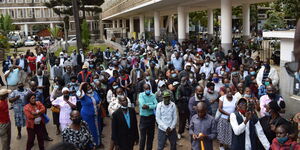A quick drive through the Nairobi Central Business District (CBD) will most likely usher a motorist to a monument around a looping course at an intersection between Moi Avenue and Haile Selassie Avenue.
Towering above all motorists and pedestrians is the Nairobi Obelisk monument that generously watches over the city.
Its design was described as strange and largely bewildering to many residents who neither understood it nor its mystical inspiration.
An obelisk is a tall narrow tapering monument that ends in a pyramid-like shape or pyramidion at the top.
It is not clear who is behind the lofty monument that faces a number of prominent offices including that of Prime Cabinet Secretary Musalia Mudavadi.
An inquiry that was placed before Nairobi County over the same monument went unanswered even as members of the public continued to raise questions.
As such, it is not currently possible to reveal those who were behind the construction of the Nairobi Obelisk.
However, legally, all Kenyan monuments are managed by the government through the Ministry of Culture and Sports.
Historically, Obelisks do trace their roots to Egypt where they were built for various mystical reasons, including cultural, traditional, financial and religious roles.
Originally Obelisks were constructed to define religious and financial strongholds where the religiously wealthy individuals resided and partook somewhat clandestine rites.
Ancient obelisks were monolithic like Cleopatra's Needle in New York City, which was relocated from the ruins of the Caesareum of Alexandria in the 19th century to the United States of America.
Modern obelisks are more decorated and consistent with current architecture like the one at Moi Avenue roundabout.
In Egypt, obelisks were also built at the entrance of major cities, ancient temples and mosques which were frequented by many people.
The whole idea about obelisk was a well-guarded secret but it was hypothesised by New York University Egyptologist Patricia Blackwell Gary and Astronomy senior editor Richard Talcott that the shapes of the ancient Egyptian pyramid and obelisk were derived from natural phenomena associated with the sun.
The sun-god being the Egyptians' greatest deity at that time had a major influence on the economy of the land.
Some of the influences included astronomical phenomena that were connected with sunrise and sunset, a Zodiacal light and sun pillars that defined trade.












